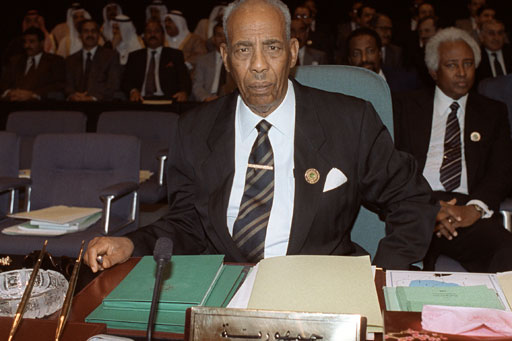
Friday, November 02, 2012

A picture from May 29, 1990 shows Somali President Mohamed Siad Barre at an Arab Summit. Barre ruled Somalia from October 1969, when he led a military coup against the democratically elected government, until January 1991, when the central government collapsed. [Mike Nelson/AFP]
In 2012, Somali lawmakers succeeded in passing a new constitution, and then elected Hassan Sheikh Mohamud as president in the first election held in Somalia in more than two decades.
January 26, 1991: President Mohamed Siad Barre is ousted. A power struggle between clan warlords kills or wounds thousands of civilians.
June 1991: Five months after the fall of Somalia's central government, President Hassan Guled Abtidon of Djibouti invited Somalia's warring factions for talks for the first time in Djibouti.
July 1991: A second conference is held in Djibouti and participating parties agree to appoint Ali Mahdi Mohamed as the interim president of Somalia for two years.
General Mohamed Farah Aidid rejects the appointment of Mohamed as the interim president.
January 1993: The United Nations sponsors a meeting for warring factions in Addis Ababa, Ethiopia to end the ongoing civil war.
March 1993: Rival factions sign the Addis Ababa Agreement in which they agreed to reconciliation and disarmament, but the civil war continues, and the agreement falls apart.
October 1996: Kenyan former President Daniel Arap Moi invites three main faction leaders -- Ali Mahdi Mohamed, Hussein Aidid and Osman Atto -- for peace talks in Nairobi.
November 1996-January 1997: Moi's peace efforts are hampered when Ethiopia invites 26 factions to a peace conference in Sodere, Ethiopia. The Sodere talks run from November 1996 to January 1997, with 41 tribal leaders representing the 26 factions.
November 1997: The Sodere's conference is derailed by another reconciliation conference held in Cairo for Somalia's warring parties.
May 2000-August 2000: Djiboutian President Ismail Omar Guelleh hosts the Somalia National Peace Conference in Arta, which establishes the Transitional National Government (TNG). Somali representatives elect Abdiqasim Salad Hasan as TNG president.
December 2003: The TNG's administrative body reports bankruptcy.
October 2002-October 2004: The Inter-Governmental Authority on Development (IGAD) sponsors the Somali National Reconciliation Conference in Eldoret, Kenya. The talks result in the adoption of the Transitional Federal Charter and the election of Abdullahi Yusuf Ahmed as president of Somalia's Transitional Federal Government (TFG), which replaces the TNG. The TFG is to move Somalia out of transition by August 2009 when its mandate expires.
June 2006-December 2006: The Islamic Courts Union (ICU) led by Sheikh Sharif Sheikh Ahmed rules most of southern Somalia after ICU forces oust Somali warlords from Mogadishu.
December 2006: Somali and Ethiopian forces capture Mogadishu after the ICU is forced out of the city.
January 2007: The African Union's Peace and Security Council establishes the African Union Mission in Somalia (AMISOM) as a peacekeeping force with an initial mandate of six months to support reconciliation efforts. The UN Security Council also approves the mission in February.
September 2007: ICU leaders and opposition figures from the TFG meet in Asmara, Eritrea and form the Alliance for the Re-liberation of Somalia (ARS).
June 2008: Government signs a three-month ceasefire pact with the ARS in Djibouti, but ARS leader Hassan Dahir Aweys rejects the truce, causing the organisation to suffer internal splits.
May 2008-June 2008: Representatives of the TFG and the ARS meet in Djibouti between May 31st and June 9, 2008 and sign a peace agreement.
January 2009: Somali lawmakers elect TFG President Sheikh Sharif Sheikh Ahmed in Djibouti and extend the TFG's five-year mandate for another two years.
February 2011: Somalia's parliament votes to extend the mandate of the Transitional Federal Institutions for another three years with resistance from international observers. Subsequently a feud arises between the speaker of parliament and the president, each requesting that only his own term be extended.
June 9, 2011: TFG President Sheikh Sharif Sheikh Ahmed and Speaker Sharif Hassan Sheikh Aadan sign the Kampala Accord extending the term of all transitional federal institutions for one year. Under the agreement, the TFG is required to adopt a federal constitution, elect a president and bring Somalia's transitional phase to closure by August 20, 2012.
September 6, 2011: Somali and international leaders in Mogadishu announce the Roadmap, a list of dozens of tasks to steer Somalia towards permanent government. It includes measures for countering piracy, co-opting local militia groups, planning for elections, developing peace-building initiatives and tackling corruption.
December 24, 2011: Leaders from across Somalia sign the Garowe Agreement, creating an outline for permanent government and establishing a quota for women's representation in parliament.
February 18, 2012: Leaders from across Somalia sign the Garowe II Agreement, establishing a framework for a federal structure, electoral and parliamentary systems that will replace the TFG in August.
March 26, 2012: Somali leaders in Galkayo agree to implement key steps within the Roadmap to end the transitional period, expanding on previous Garowe agreements and further outlining steps to unify Somalia's regional governments.
May 31-June 1, 2012: Somali and international leaders meet in Istanbul, calling on the international community to continue its support for building and adequately equipping the Somali security forces, including the national police force, navy, coast guard and intelligence agencies during the Somali reconciliation process.
June 20-21, 2012: An official two-day meeting between representatives from the TFG and Somaliland is held in London, launching direct negotiations between the two parties for the first time in more than 20 years.
May 21-23, 2012: Signatories of the Roadmap meet in Addis Ababa and agree on a series of deadlines to build relevant institutions and adopt a new constitution for Somalia.
August 1, 2012: Somali National Constituent Assembly delegates vote overwhelmingly in favour of adopting a new constitution for the country.
August 20, 2012: Somalia's new parliament is sworn in at the airport in Mogadishu, marking the end of the country's transitional period.
September 10th, 2012: Somali parliamentarians elect President Hassan Sheikh Mohamud in the first presidential elections held inside Somalia in over two decades.